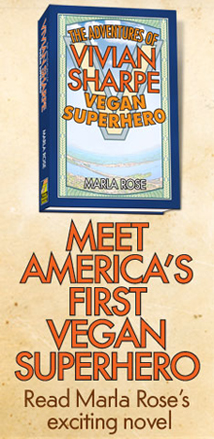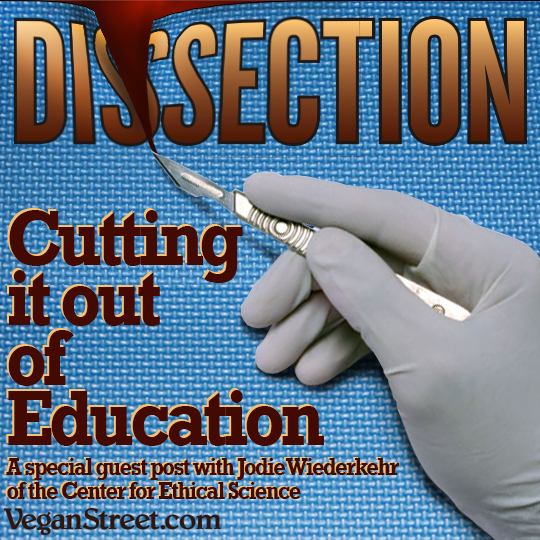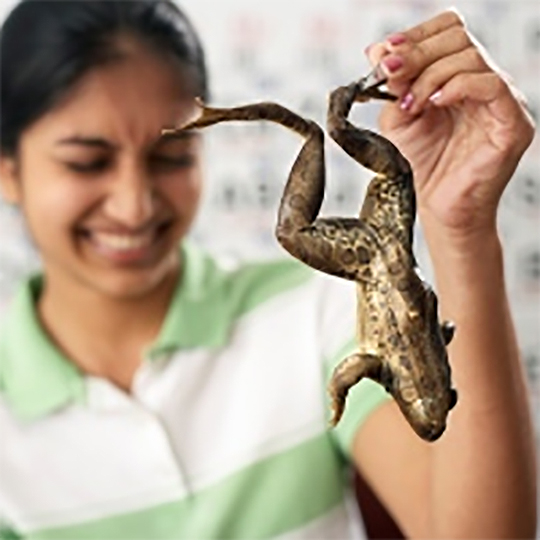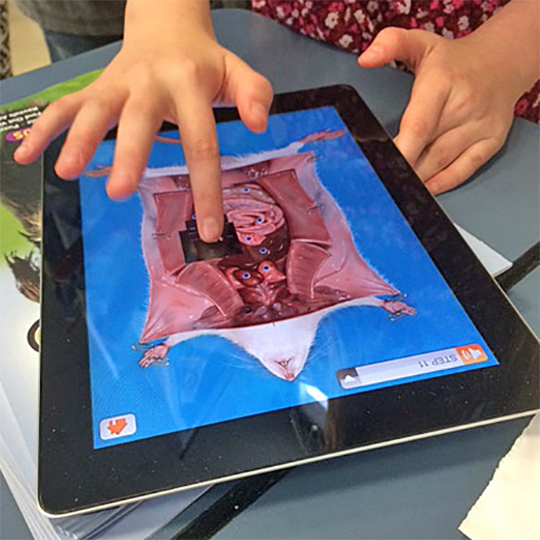

Available in either softbound or Kindle/Nook/etc. eBook at Amazon
viviansharpe.com

  Dissection: Cutting it out of Education a special guest post from Jodie Weiderkehr of the Center for Ethical Science Many years ago, I was a sophomore at a big, competitive high school and I was facing my first biology unit that included dissection. I remember our individual kits of sharp, shiny instruments, I remember our work book, I remember being assigned into pairs, I remember our scruffy science teacher with the beard and I remember the little fetal pigs suspended in jars of formaldehyde, bobbing as if in slow motion, their soft features formed in miniature, born dead. I was not a terribly assertive person at this age – 15 – and I was not yet a vegetarian but something about this unit and the absolute, unconquerable disgust it summoned in me as our classes began, we were instructed to cut the skin, remove organs, poke around, made me ask the teacher for some kind of alternative. Every day as I’d go to class, I’d start to get a knot in my stomach on the way down the hall before that first whiff of formaldehyde even hit me but once it did, I was so dizzy and nauseated, I felt like I was seasick. I can still smell it today. One day not long after the unit began, I met with the teacher and asked if there was any way I could have alternative assignments that did not involve dissection. I remember he scrutinized me pretty closely – was I just trying to get out of work? Was I being a drama queen – and he asked me a bunch of questions but he finally nodded. I was the first student to ask for this provision, he said, but he thought that I could work on this newfangled computer model he had to understand the anatomy they were studying in the classroom. So each day, while the other students were in the dissection lab, I sat in his office and learned where the kidneys were, what the heart looked like. They resented me for this – someone put a fetal pig liver in my backpack – but I got out and my partner was assigned with another pair. Within weeks of beginning this unit, I became a vegetarian, seemingly out of nowhere, but I really think that the dissection unit set the stage. While there is still a very long way to go with this antiquated, cruel model of dissection, we have also come far from my days in the 1980s of trying to figure out what on earth I was going to do. I am grateful to people like Jodie Wiederkehr of the Center for Ethical Science who is helping to move us beyond dissection and toward a more accurate, humane and modern template for learning anatomy, and for helping students who want to opt out of it. I wish I had an ally like Jodie back in the day but short of that, I am happy she is available today to help us finally evolve beyond this corrupt, inhumane and backwards model. Before forming the Center For Ethical Science, Jodie worked professionally in animal protection for thirteen years, including as Signature Campaign Director with The Committee to Protect Dogs to help place the Greyhound Protection Act on the November 2008 Massachusetts ballot. which ended greyhound racing in MA. She also worked for two national anti-vivisection organizations and SHARK. - Marla Rose By Jodie Wiederkehr Definition of biology: a natural science concerned with the study of life and living organisms. What’s wrong with animal dissection you may ask? Well, many things, but mainly it’s: • cruel • dangerous • environmentally hazardous • unnecessary  CRUEL: According to Jan Oakley, Ph.D., of Lakehead University, an estimated 10 - 12 million animals are dissected each year for classroom-based dissections in the U.S. alone. • Millions of animals are bred to die (cats, mice, rabbits, rats, etc.) • Class B dealers (Bunchers – stolen dogs and cats) • Animals stolen from nature (dogfish sharks, earthworms, frogs, perch, turtles, etc.) • Slaughterhouse and meat industry by-products (cow eyes, fetal pigs, sheep brains, etc.) • Fur farm leftovers (mink) DANGEROUS: Not only is animal dissection an obvious danger to animals, but it’s not safe for the students either. “If you can smell formaldehyde* then you may have exceeded the OSHA action or exposure limits.” US Environmental Protection Agency (EPA). Dissection gives youth the dangerous notion that animals are here for us to use and abuse. • There is a direct link between cruelty to animals and violence toward humans • Many harmful chemicals are used to preserve specimens • Desensitization Disturbing footage from a biology class at Oklahoma City’s Harding Charter Preparatory High School, shows at least eight lab coat-clad students and one apparent ‘conductor’ moving the feline cadavers in unison to music that sounds like the popular Meow Mix cat food jingle. Students bob the dead animals up and down, line them up to fall down like dominoes and make the lifeless creatures touch paws as if high-fiving. Do you ever wonder how animal experimenters get to the point where they can perform some of the incredibly inhumane experiments we hear about such as stealing baby monkeys away from their mothers after birth and subjecting them to frightening situations or paralyzing three-month-old kittens, etc.? When students are taught from a young age that animals are here for us to cut up and learn from, they slowly become desensitized, so it’s no surprise that a student who is taught to enjoy dissection might grow up to enjoy vivisection (experimenting on live animals). • Sharp weapons This may not seem dangerous, but with the amount of violence in schools, I think it should be taken seriously. ENVIRONMENTAL HAZARDS: To supply dissection in classrooms, millions of frogs are “harvested” and are returned to the environment as chemical laden toxic bodies and body parts. “Amphibians are experiencing a precipitous decline across the globe, according to the first comprehensive world survey of the creatures, which include frogs, toads and salamanders. As many as 122 species have disappeared since 1980, and 1,900 are in danger of becoming extinct.” The Washington Post, October, 2004. Two of the biggest purveyors of dead animal specimens are Carolina Biological and Ward’s Science. UNNECESSARY: 99 percent of medical schools exclusively use human-relevant methods - not animals - to train future physicians. Technology has advanced so much that human-based medical simulators can easily replace this use of animals. All leading medical schools, including Stanford and Harvard, teach medical students without the use of animals so, there is absolutely no need for elementary, middle and high schools to continually be teaching an outdated and inhumane methodology just because it’s what has been done for decades. THE GOOD NEWS: • Student choice laws/policies • State-of-the-art tools • Cost-effective • Not required STUDENT CHOICE LAWS/POLICIES: There are many states that have enacted student choice laws or policies. My home state of Illinois passed a Student Choice Law in 2000. To see the latest news of where your state is in terms of dissection choice laws, you can also check out this list on AAVS. STATES WITH DISSECTION CHOICE LAWS OR POLICIES: • CALIFORNIA • CONNECTICUT • FLORIDA • ILLINOIS • LOUISIANA • MAINE • MARYLAND • MASSACHUSETTS • MICHIGAN • NEW HAMPSHIRE • NEW JERSEY • NEW MEXICO • NEW YORK • OREGON • PENNSYLVANIA • RHODE ISLAND • UTAH • VERMONT • VIRGINIA • WASHINGTON, DC STATE-OF-THE-ART TOOLS & COST-EFFECTIVE ALTERNATIVES: There are numerous online tools to learn the life sciences and many of these programs are free. There are also lending libraries around the country that lend models, software, manikins, videos, etc. that are free of charge. When you take this into consideration, along with the constant financial constraints most schools face, buying 20 -30 animal specimens, along with all the laboratory supplies each semester, it really adds up. Here are a few state-of-the-art online programs available to students and schools to learn human anatomy, which is generally the goal of dissection: Froguts Visual Dissections McGraw Hill Anatomy and Physiology Exploratorium - Cow's Eye Anatomy There are many more online to use. NOT REQUIRED: As the Physician's Committe for Responsible Medicine (PCRM) says, “The National Association of Biology Teachers, the National Science Teachers Association and the Human Anatomy and Physiology Society all endorse and encourage the use of computer-based dissection programs for all levels of science education.” In a statement I was sent from the National Student Nurses’ Association, Inc., in Nov. 29, 2000, “Students have the right to object to participation in cat dissection without penalty but rather are provided an alternative to fulfill the students’ responsibility to satisfy their educational requirements.” So, as you can see, animal dissection is not necessary to excel in middle school, high school nor is it required to get into college, veterinary school or medical school.  STEPS TO TAKE TO BE A CONSCIENTIOUS OBJECTOR: • Talk to the teacher/school as soon as possible – work on passing a student choice policy at your school • Elevate the issue up the ranks if necessary (Teacher/Principal/Superintendant) • Offer to borrow or buy some programs for the school • If you live in a state without a law, meet and discuss the issue with your legislators – stress the savings to schools • Contact me at the Center for Ethical Science (CFES) or Facebook or Twitter Lastly, please remember that it doesn’t matter if you live in a state that doesn’t have a Student Choice Law because YOUR MORAL BELIEFS = YOUR ETHICAL BELIEFS = YOUR RELIGIOUS BELIEFS. Basically, how you live your life constitutes your personal religious beliefs and this is how a student will always win the right to learn humanely and not dissect or vivisect an animal in school. © 2015, Vegan Street |













 |
 |
 |
 |
 |
 |
 |
